At a certain age, people around you tend to spontaneously form conservatorships. As an example, several associates determined that my cell phone was obsolete. Without my participation, a meeting was called, a consensus was reached and a replacement phone was ordered. Gone was my nifty clamshell with pull up antenna and Odd Couple ring tone, received was a sliverous, snooty iPhone. Now, with the magic of Facetime, not only can callers interrupt me at will, they can now force me to see their giant pumpkin heads as they speak. The arrival of new and better things is inevitable.
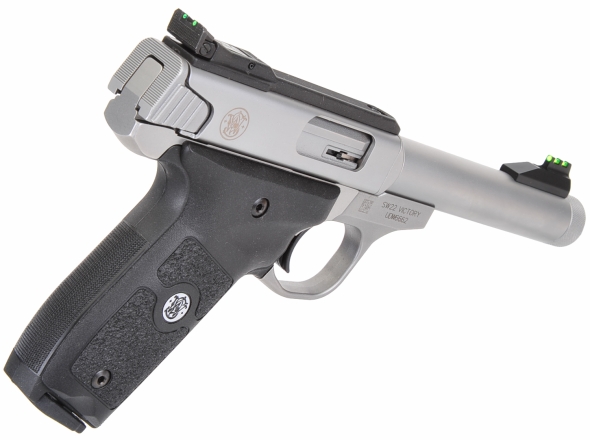
Really good products offer solutions to competitors’ product deficiencies. Inferred within Smith & Wesson SW22 Victory Target Pistol Part 1, the S&W Victory delivers reliability and precision, but it also is easy to disassemble for cleaning, maintenance and modification. The stainless steel frame and limited use of polymer makes it a more substantial product. The fact it is so good looking doesn’t hurt when a buy decision is being contemplated.
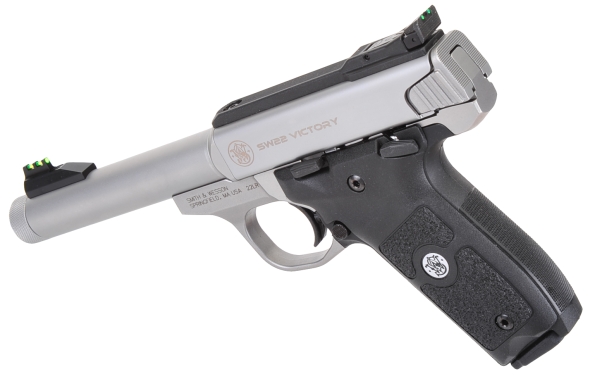
I’ve worked with pistols that require the simultaneous use of three to four hands and where reassembly is more difficult than a burr puzzle. I’ve also shot some vacuous mechanical beauties that fell to malfunction with every trigger pull. The S&W SW22 Victory never offered up a surprise ending to a trigger pull and it is one of the easiest assemblies to work with in a 22 rimfire pistol.
Taking advantage of potential
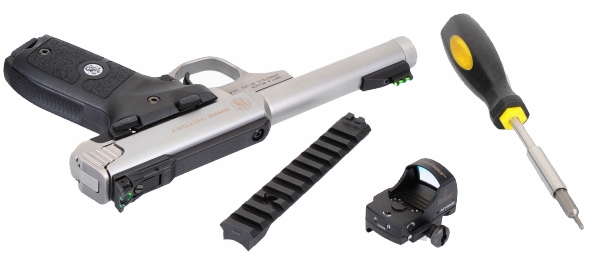
As the S&W Victory can shoot with precision beyond its metallic sights a fiber filled polymer rail is supplied with the pistol. The rail is Picatinny standard, which will accommodate any number of electronic and optical sights. A 7/32″ hex bit is required to remove “A” and a small common to back out “C” to avoid scratching the top of the receiver when pushing the sight base out of tab “B”.
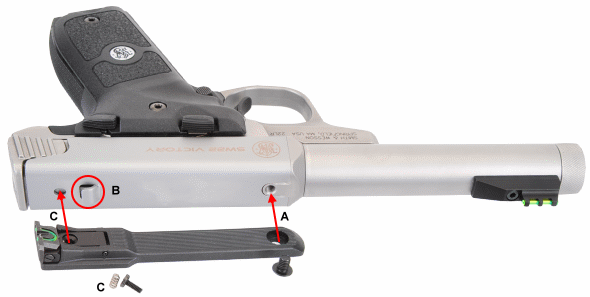
In the event “C” is fully removed, keep an eye out for a small hex nut under the sight base that secure the vertical sight adjustment screw and the tension spring that resides under the sight elevator. On reinstalling the adjustable sight, it is important to fit the spring into the retaining recesses in the base and elevator to assure full sight adjustment. Not as complicated as it sounds. The task takes less than a minute.
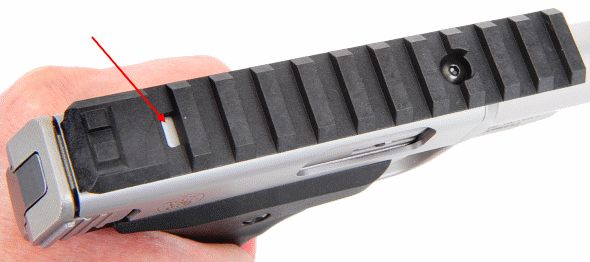
With the front screw in place, the rail is locked into the tab on the top of the receiver. The rail has a rear sight notch so the pistol can be shot in with the rail, but no electronic or optical sight in place.
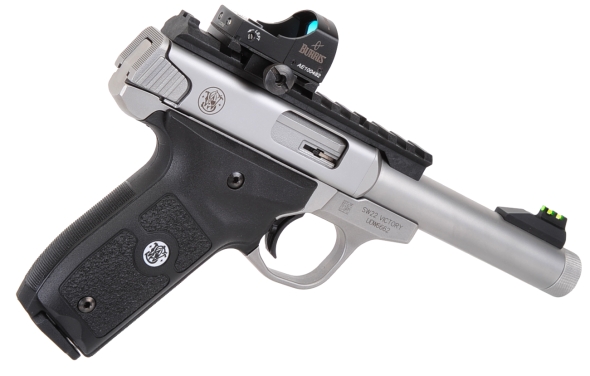
The pistol was shot with metallic sights, Burris red dot and handgun scope. The scope was the most precise, but shooting with the red sit and both eyes open proved to be the fastest set up.
How fast is that 1,300 fps ammo?
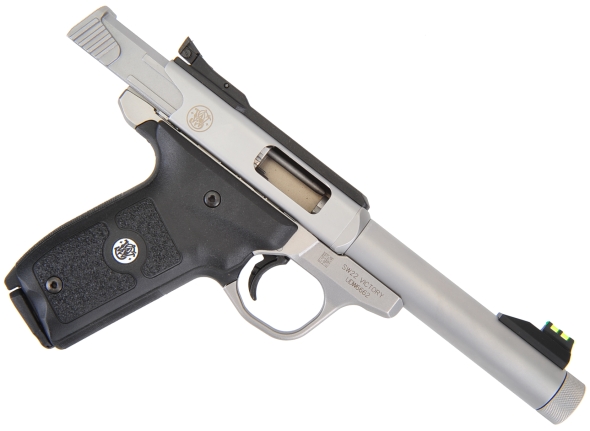
Shooting was limited to a 22 LR rimfire cross section of six types of ammunition. Within the mix, the gummy, the smoky, the fast, and the mope are represented. This mix will almost always flush out any reliability or accuracy issues with a rimfire autoloader under evaluation. All ammo was shot in unsuppressed and suppressed configurations as this can influence function, velocity and accuracy.
| Ammunition | Bullet Weight Grains |
Bullet Type |
Mfg Rated FPS |
5.5″ Barrel Actual FPS |
Suppressed Actual FPS |
50 Ft 3 Shot Group” |
| Remington Cyclone | 36 | HP | 1280 | 1137 | 1189 | 0.9 |
| Eley Subsonic | 40 | RN | 1040 | 942 | 979 | 0.6 |
| Remington High Velocity | 40 | RN | 1255 | 1064 | 1107 | 0.4 |
| Remington Thunderbolt | 40 | RN | 1255 | 1085 | 1083 | 0.7 |
| Peters | 40 | RN | 1255 | 1046 | 1070 | 0.7 |
| Winchester Super Speed | 40 | RN | 1300 | 1110 | 1162 | 0.8 |
|
Chronograph 10′ from muzzle – Groups shot from a rest with Burris FastFire |
||||||
Seven and ten yard groups were omitted, as the primary intent of this pistol is not self defense. 50 feet seemed a good test for small game hunting and recreational bragging rights competition. Yes, velocity almost always increases with suppression, in this case an Advanced Armament Aviator 2 silencer. Group sizes are expressed in nearest tenths of an inch… because I’ve not found a way to measure a piece of ragged paper accurately to one thousandth of an inch.
In the case of the Smith & Wesson Victory live fire component, only the Cyclone and Super Speed ammo generated a mild sonic crack. The others were no louder than the mild cycling sound of the action. The group sizes on the table were recorded without the silencer in place, however, groups shot with the silencer were statistically the same, but with a slight shift in point of impact.
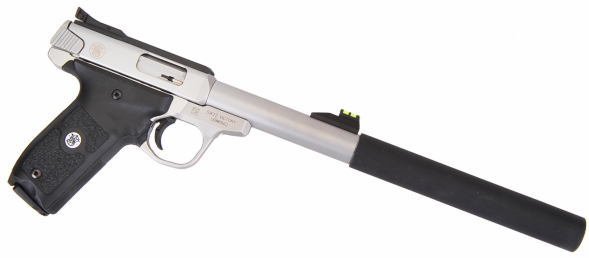
As a pragmatist and firearm enthusiast, the use of a silencer to suppress a firearm means something quite different than Hollywood’s abuse of firearm imagery and left wing antigun rhetoric and demagoguery. Suppression extends the life of my hearing, makes shooting less irritating to neighbors and reduces environmental disturbances when hunting. As a hard working, law abiding U.S. citizen, I don’t know any criminals, so it is difficult for me to fathom the sinister boogie man the left conjures when they want to frighten the general population over the use of silencers.
So what does this all mean?
The Smith & Wesson SW22 Victory is a well made, good looking, reliable pistol. It is a terrific recreational target pistol as shipped and it can be made into a great hot rod by integrating third party specialty pieces. Certainly worth a long look for anyone in the market for a rimfire pistol.
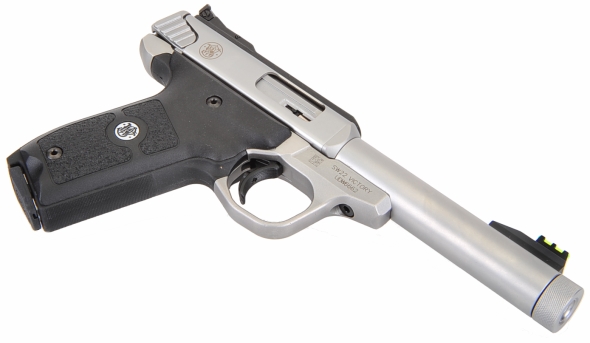

Email Notification